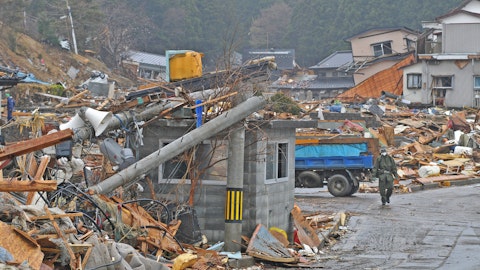Andrew Andersen: Thank you.
Mac Armstrong: Thanks, Andrew.
Operator: [Operator Instructions] Our next question is from Meyer Shields with KBW. Please proceed with your question.
Meyer Shields: Great, thanks. Good morning. A bunch of like quick questions, if I can. First, I know Cincinnati is targeting higher net worth homeowners. And I’m wondering, does that translate into maybe writing accompanying residential earthquake on non-admitted paper?
Mac Armstrong: Meyer, I apologize, we lost you for a second. Would you mind repeating that question? I heard the second-half on non-admitted paper, but we didn’t hear the first part.
Meyer Shields: Yes. No problem at all. I know Cincinnati is looking to grow its high-net-worth homeowners, and I’m wondering whether that affords you the opportunity to write the Earthquake on non-admitted paper.
Mac Armstrong: Yes, I’m sorry. It is on a non-admitted basis. So we are writing that as an E&S policies and a company to their high-net-worth E&S offering in California.
Meyer Shields: Okay. Perfect. On Crop, I think Chris said that 30% of the written premiums come in the first quarter and the balance in the third. Is that a normal run rate? Or when you’re ramping up, should we see higher percentages in the first quarter than this year?
Jon Christianson: Hey Meyer it’s Jon Christianson. For the next few years, we’d expect that to be fairly consistent. And so, you’ll see the third quarter be, by far, the largest quarter of written premium. The second largest will be the first quarter, and then there’ll be a little bit in the second and the fourth quarter, but really, the third quarter is going to be where you’d expect to see the largest premium share for the year.
Meyer Shields: Okay. Perfect. And I know the retained premiums are going to be really, really low. But there are different approaches that a lot of the crop insurers take in terms of booking profitability for that line of business. In other words, waiting until, let’s say, the fourth quarter before taking the combined ratio on the retained book below 100%. How is Palomar planning on, I guess, booking that line?
Jon Christianson: Yes. It’s a good question. The third quarter premium that we book will have a little bit of a catch-up effect with it. A lot of that premium is originated earlier. And then, we wait for the acreage reports to come in, which generally will start coming in June-ish, but mostly in July. And so, at that point in time, we will book all of the written premium, and then there will be a slight catch-up of earned premium, which obviously comes with a combined ratio. So there will be some earning of it in the third quarter as — and then throughout the remainder of the year, as most of that does end at the end of the year. So we will be booking most of written premium, but then some of those, call it, the profitability through the third and the fourth quarter for that book of business.
Chris Uchida: Yes. Meyer, I’d say that we’ll look similar to others in the market in terms of how we — the timing of when those profits are taken in or recognized. Usually, the modeling becomes clear at the end of the third quarter and into the fourth quarter, which gives you more confidence on the loss ratio for the year.
Meyer Shields: Okay. Perfect. And last question, and I’m not exactly sure how to ask this, but Mac, you talked about being bigger and how that should allow for growth on more accounts. Is there any way of, I don’t know, ballparking it or describing the relevance of the higher-size category?
Mac Armstrong: Yes. Meyer, I think it’s hard for us to quantify right now. We had a commercial underwriting meeting a week or two ago. And our underwriters were pleased that with the increase in financial size quarter, it’s probably most relevant for our environmental team and our professional liability team. But then, they immediately asked when are we going to get an A rating? So, that might be more impactful. So I would love to say it’s a lot like what it was in 2020 when we got over $250 million, and that opened up a few different distribution channels that we couldn’t see previously. Now it’s just more about insured appetite and the credit rating requirements for certain larger accounts. So I can’t quantify it right now. I think it’s going to open up a lot, and I think it would definitely help from a recruiting standpoint. But I’d love to give you a dollar number. I just can’t right now.
Meyer Shields: Okay, fair enough. Thank you so much.
Mac Armstrong: Thanks, Meyer.
Operator: Thank you. Our next question is from Pablo Singzon with JPMorgan. Please proceed with your question.
Pablo Singzon: Hi, good morning. Maybe for Mac or Chris, you mentioned about 5% price increase on reinsurance embedded in the guidance. What dollar benefit would you get if prices go up by, say, only 4% or 3%? I know the dollar cost of XOL will also depend on exposure and structure. But holding all that constant, how much dollar savings do you get if reinsurance pricing is more favorable than what you’re assuming?
Chris Uchida: Yes. That’s a great question. When you look at our book, and we’ve talked about it before that the cost of risk transfer last June 1 was about $230 million, right? So we will be buying more excess of loss reinsurance to cover the increase in our exposure. So let’s say, when our exposure went up 10%, let’s call it, $250-ish million, $253 million that we’re going to be spending, right? We were expecting some sort of rate increase. Right now, we’re saying 5% on top of that. So you kind of do that math. So you just kind of work it backwards. If you have a 1% savings on $250 million, that’s $2.5 million over the full treaty year. So from our standpoint, that’s probably the right way to think about it when you go in there.
Now not saying that’s our exposure change or anything like that. But just when you want to do the math, that’s a good rule of thumb. $230 million is probably the right base to think about what our opportunity is or what our potential additional cost is going to be at the next renewal.


